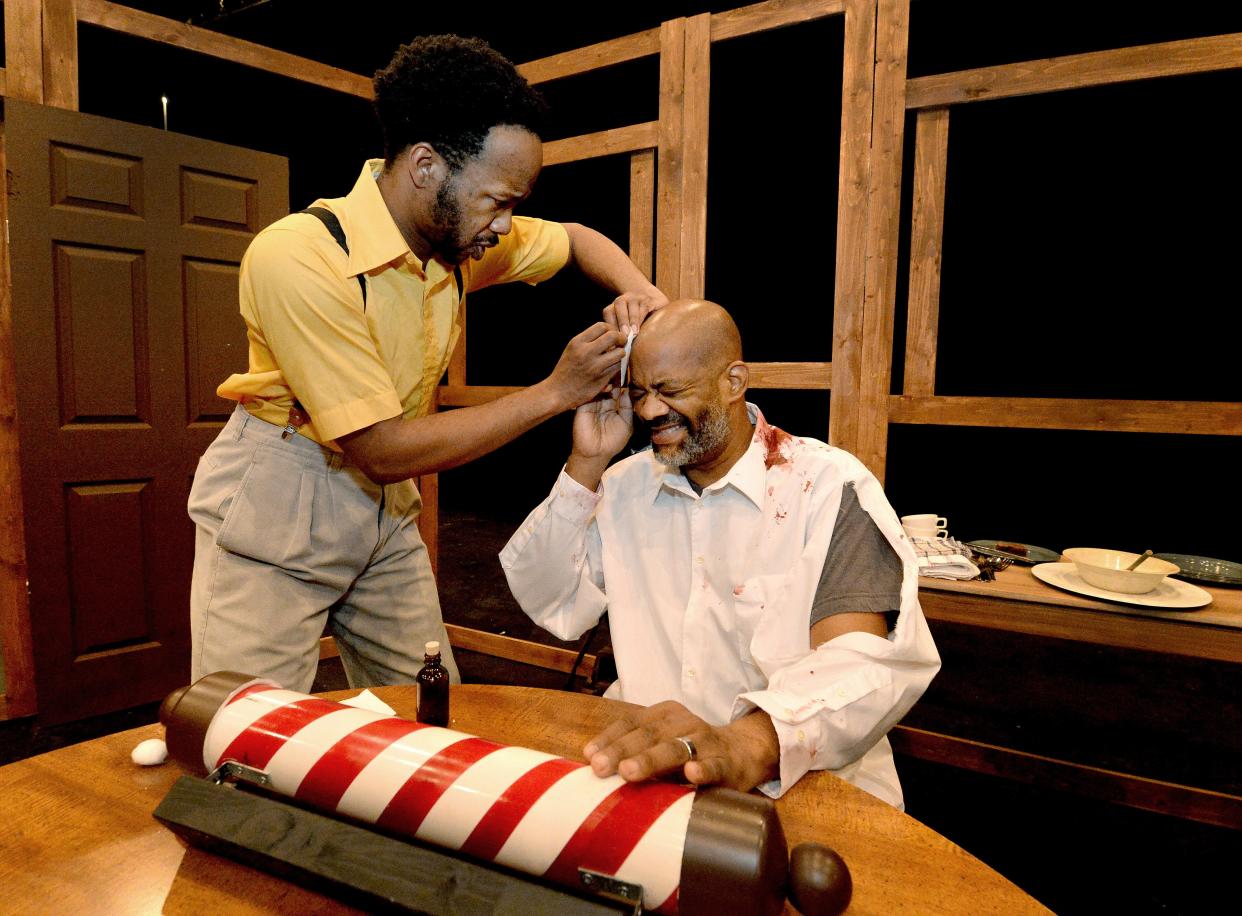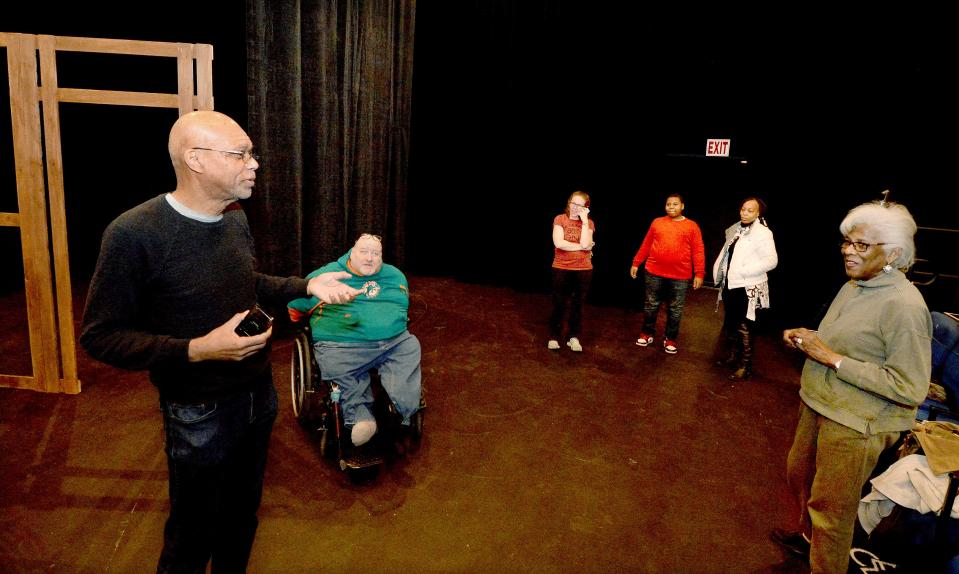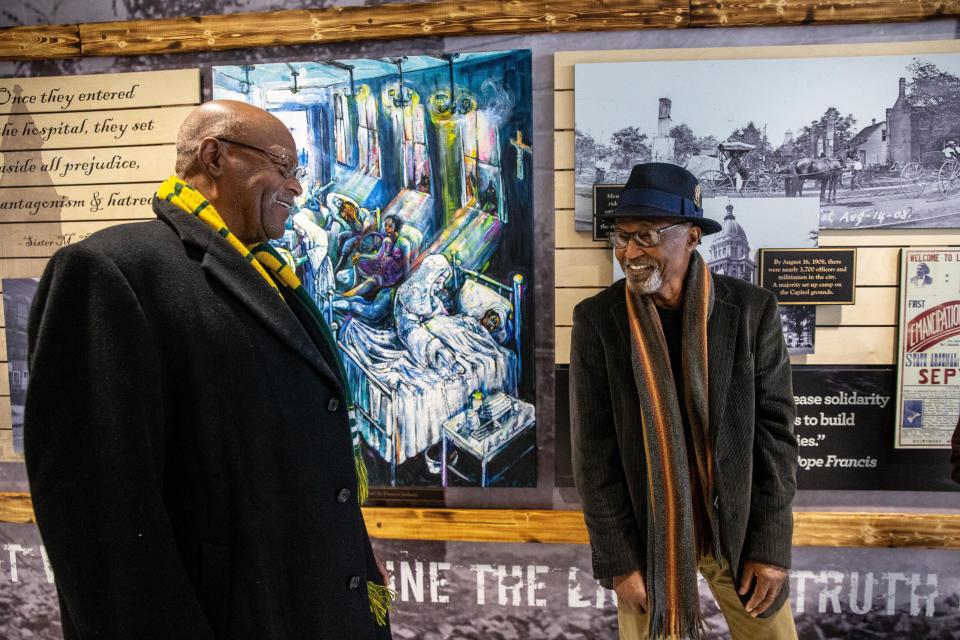Playwright hopes original work about 1908 race riot can jumpstart conversations

Playwright Tim Crawford doesn't think the city of Springfield has come to a reckoning about its 1908 Race Riot, during which two Black men were lynched and dozens of Black-owned homes and businesses were destroyed.
"I think we've gotten to recognition. I think recognition is well on its way," said Crawford, who has lived in Springfield since 2009. "Reckoning for the events of 1908 isn't going to come about unless people talk about it, think about and search their souls about it."
Crawford is hoping his play "Outraged: Terror in Springfield 1908," which debuts at the University of Illinois Springfield Studio Theatre Friday through Sunday, will help jumpstart some of that necessary conversation.
'Important effort': Illinois Underground Railroad Task Force works to connect projects
The play, through the character Bonaparte Baker − a Springfield native and Civil War veteran − connects the real-life events of Wilmington, N.C., where a political coup d'etat turned massacre killed upwards of 250 people in 1898, to Springfield.
Baker is confronting the family of his wife, who was killed in Wilmington, after a decade-long silence. Stepping off a train smack dab into the middle of the racial upheaval in Springfield, Crawford has Baker bound for East St. Louis, where in less than a decade, there will be another race riot.
"(Wilmington) was important to me (to have) in the play," said Crawford, the Our Stage/Our Voices artist-in-residence at the UIS Performing Arts Center. "It sort of cemented the connection I wanted to have with a previous racial event that Bonaparte had been a part of. That was always part of my thinking, that he was coming from one pillar to the next post and to the next."

Our Stage/Our Voices provides opportunities for performing artists who are members of historicallyunderrepresented communities. Crawford, who has been artist-in-residence since 2022, leaves the position next month.
A native of Chicago's Englewood neighborhood who retired from the Illinois Education Association in 2017, Crawford said he knew little about the Springfield Race Riot until 2018 when he encountered a video of Peoria artist Preston Jackson telling the story of his mural depicting the Hospital Sisters of St. Francis caring for the victims. The mural was a centerpiece for an exhibit commemorating the centennial of the riot at the Women and Children´s Clinic at HSHS St. John´s Hospital.
Seeing the exhibit "Something So Horrible" at the Springfield and Central Illinois African American History Museum, the same exhibit the Abraham Lincoln Presidential Museum hosted a decade before, and encounters with fellow playwright and director Phil Funkenbusch and retired librarian and researcher Kathryn Harris oriented Crawford toward plumbing the subject deeper.
"It has to do," he said, "with what circles you're in, to a large extent, how much you hear about it."
Harris said she can relate to that.
![The 1908 race riot in Springfield inspired a national movement, which later led to the founding of the NAACP. [Photo from Abraham Lincoln Presidential Library]](https://s.yimg.com/ny/api/res/1.2/3WT1EPNPXPwphIW6yuCTGQ--/YXBwaWQ9aGlnaGxhbmRlcjt3PTk2MDtoPTMwNw--/https://media.zenfs.com/en/the-state-journal-register/10f7ec3580afb96c7964fadea4226a07)
The Carbondale native didn't know about the race riot until she started working at Lincoln Library's reference desk in 1972, her first job out of college.
"When my daughter was a freshman at Lincoln Land (Community College)," Harris recalled, "she wrote a paper about the Springfield Race Riot and her teacher, who was from Springfield, had never heard of it. He asked her, 'Well, how did you know about it?' She said, 'My mom told me about it. She's a librarian and she knows how to find stuff."
Harris armed Crawford with Roberta Senechal de la Roche's book "In Lincoln's Shadow: The 1908 Race Riot in Springfield, Illinois," James Krohe Jr.'s "Summer of Rage: The Springfield Race Riot of 1908" and the DVD "Springfield Had No Shame," along with numerous websites. Harris also told him about "Paint It Red," a local dramatization narrated by actors taking on the roles of key race riot figures.
From reading oral history accounts, Crawford said he got the idea to do a family drama.
"These people lived through it and here are their observations," Crawford noted. "(The thought was) what if I could bring audiences into a home, into a kitchen and let them experience (what families might have experienced) in 1908?"

Through that family −Baker's brother-in-law, Henry, owns a barber shop destroyed in the race riot − and other characters Crawford said he was trying to show that the Black community "was not a monolith. Everybody in the room has a different perspective of what is going on and where they stand in the Black community."
Crawford pointed out that one character, a helper at the barber shop, is a proponent of the Back-to-Africa Movement by sporting a Liberian pin, a notion that Baker argues against.
But Crawford said he wanted to do more than broaden perspectives: he wanted to broaden the historical palette, so he brought into play not only Wilmington and East St. Louis but also the Virden Mine Riot − a labor union conflict that had its own racial undertones and preceded Wilmington by less than a month.
About jumpstarting those conversations on race relations? Sunshine Clemons, who organized with Khoran Readus the Springfield chapter of Black Lives Matter in 2016, said art is a great tool for driving the conversation forward.
Any conversation, Clemons added, should be sustained and ongoing.
"In my opinion, these conversations need to be happening in sort of a citywide way and city leadership should be a part of that conversation," Clemons said. "And I think it's necessary that there are multiple conversations. I don't think we need to have a large-scale conversation only. I think there should be conversations within the Black community about those race relations. I think there should be conversations happening in white communities. There should be conversations that are multi-racial, that are involving all of us.
"It should be done in a variety of ways, at a variety of levels."
Clemons said BLM SPI, for instance, meets with the Springfield Police, the Sangamon County sheriff's office and the Sangamon County state's attorney's office, "but doing that by itself is not going to create city-wide systemic change in a way that could if it was happening in a multi-layered approach.
"This (play) is a good tool that can kind of re-invigorate some of those conversations that may have happened in the past that can be hard to sustain."
Viewing the "Something So Horrible" exhibit years ago, Crawford recalled he was "overwhelmed" by the content and the story, but what peeked out at him was the NAACP forming a year or so after the race riot, "sort of a symbol of hope at the end of this whole thing."
Crawford said he tried to provide his own positive visual at the conclusion of "Outraged," whose title comes from an Illinois State Journal headline.
Lucretia, whose pawnshop and home were burned down during the riot, described "a hellish sunset" to the end of that day. Crawford posits that having Lucretia do her ritualistic dance − a nightly homage to her husband who was killed in the Virden riot − as "a dance of hope and love."
"People will show up (at the play) who have an interest in those events and there's a group of people who will want to learn because it's a mystery box," Crawford added. "I also think there is a learning experience and a platform for folks to have a conversation and a discussion about (the race riot).
"(This play also might help people) think about that next step, which is a reckoning beyond the recognition. I would love to be part of that."
Contact Steven Spearie: 217-622-1788; sspearie@sj-r.com; X, twitter.com/@StevenSpearie.
This article originally appeared on State Journal-Register: An original play on the 1908 Springfield Race Riot debuts this weekend

